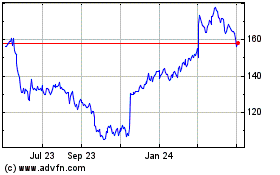By Robbie Whelan
LÁZARO CÁRDENAS, Mexico -- Latin America's most technologically
advanced shipping terminal opened here early this month, with a
ceremony attended by heads of state and shipping industry
royalty.
But the ambitious project faces an uncertain future as U.S.
President Donald Trump weighs new trade barriers.
Major importers such as Wal-Mart Stores Inc., Samsung
Electronics Co. and Target Corp. see Lázaro Cárdenas as a key link
between Asia's factories and Mexico's growing middle class. They
also hope to use the port as a backdoor to the U.S., bypassing
congested West Coast ports via the "Nafta Railway," a network of
track operated by U.S. railroad Kansas City Southern that can
shuttle goods as far north as Memphis.
APM Terminals, a unit of the world's biggest shipping company,
A.P. Moller-Maersk, spent five years and $568 million on the new
terminal. APM hopes to spend up to $900 million to expand capacity
at the terminal to rival the Port of New York and New Jersey by the
end of the next decade.
But what looked like a sure bet five years ago is less certain
today. President Trump has threatened to penalize manufacturers
that move operations to Mexico and wants to renegotiate the North
American Free Trade Agreement. Republicans in Congress have floated
a "border-adjusted tax" that would raise the cost of imports.
Any of these measures could deal a blow to U.S.-Mexico trade,
shipping companies and analysts say. Mexico's imports have grown
more than 30% since 2010, according to the World Bank, and
container volumes are up 60% in the past three years at Lázaro
Cárdenas' older facilities, according to trade data firm Panjiva.
Auto parts make up a big part of those gains.
"The port is a microcosm of global trade flows," said
Christopher Rogers, a research analyst with Panjiva. He added:
"it's very exposed to the auto industry."
Danish conglomerate Maersk, which once touted the new terminal's
"near-sourcing benefits," a reference to manufacturers producing
goods in Mexico and selling them in the U.S., now says it is
focusing more on using the port to import goods for Mexico's
consumer market.
In an interview this month, Maersk Chief Executive Soren Skou
said "the main purpose of the terminal is to be a gateway terminal
for the Mexico City market," with cross-border trade secondary.
"The U.S. administration has made a number of statements that
impact our business on the positive side," Mr. Skou said. "Then
there are the discussions about trade deals, and some of the
rhetoric seems more protectionist...It's really hard for us to
judge how this will affect our business."
APM's terminal unloaded its first ship in February, and the port
formally opened with a ceremony in early April attended by Mexico's
president Enrique Peña Nieto and Danish Prime Minister Lars Løkke
Rasmussen.
Mexico's government sees developing the port as a priority. In
2013, amid rising drug cartel violence and illegal smuggling, Mr.
Peña Nieto deployed thousands of troops to the port and handed over
its security to the navy, which still maintains a garrison
there.
At the ceremony earlier this month, he called the terminal "a
testimony to how Mexico has been growing, how it has become a
trustworthy destination...that is crucial for the transit of goods
bound for the important consumer market that is Mexico, and from
here to other important consumer markets."
However, in recent months, Mexico's president has also said the
country will pursue trade deals with Vietnam and Japan and work
more closely with China.
"Mexico's path forward is to participate more in world trade,
not just to trade with North America," said Walter Kemmsies, an
economist who specializes in ports and shipping. "The investment at
Lázaro Cárdenas makes sense, because it's a gateway to trade with
Asia."
On a stiflingly hot morning in late March, giant cranes lifted
hundreds of metal boxes from the container ship Charlotte Maersk
amid the soft hum of robotic machinery.
The new terminal features towering 300-foot-tall ship-to-shore
cranes that can span the largest container ships currently plying
routes between Asia to North America.
The cranes can pluck two containers at a time from ships, then
deposit them in piles. Robotic stacking cranes that run on
electricity -- rather than the usual diesel -- use artificial
intelligence to arrange the piles in the most time- and
cost-efficient order. Such semi-automated systems are common at
port terminals in the Netherlands and Singapore, but have never
been used in Latin America.
The facility is expected to employ about 550 people -- or 250
fewer than a similar-size terminal without automation -- which
makes for fewer accidents and lowers container handling costs by
20%, APM says.
"I've never seen a terminal this technologically advanced," said
Miguel Ángel Dominguez, a supervisor for cargo operations at the
terminal. "It's much safer, much more dynamic, much more
mechanized."
Write to Robbie Whelan at robbie.whelan@wsj.com
(END) Dow Jones Newswires
April 16, 2017 07:14 ET (11:14 GMT)
Copyright (c) 2017 Dow Jones & Company, Inc.
Target (NYSE:TGT)
Historical Stock Chart
From Mar 2024 to Apr 2024

Target (NYSE:TGT)
Historical Stock Chart
From Apr 2023 to Apr 2024
